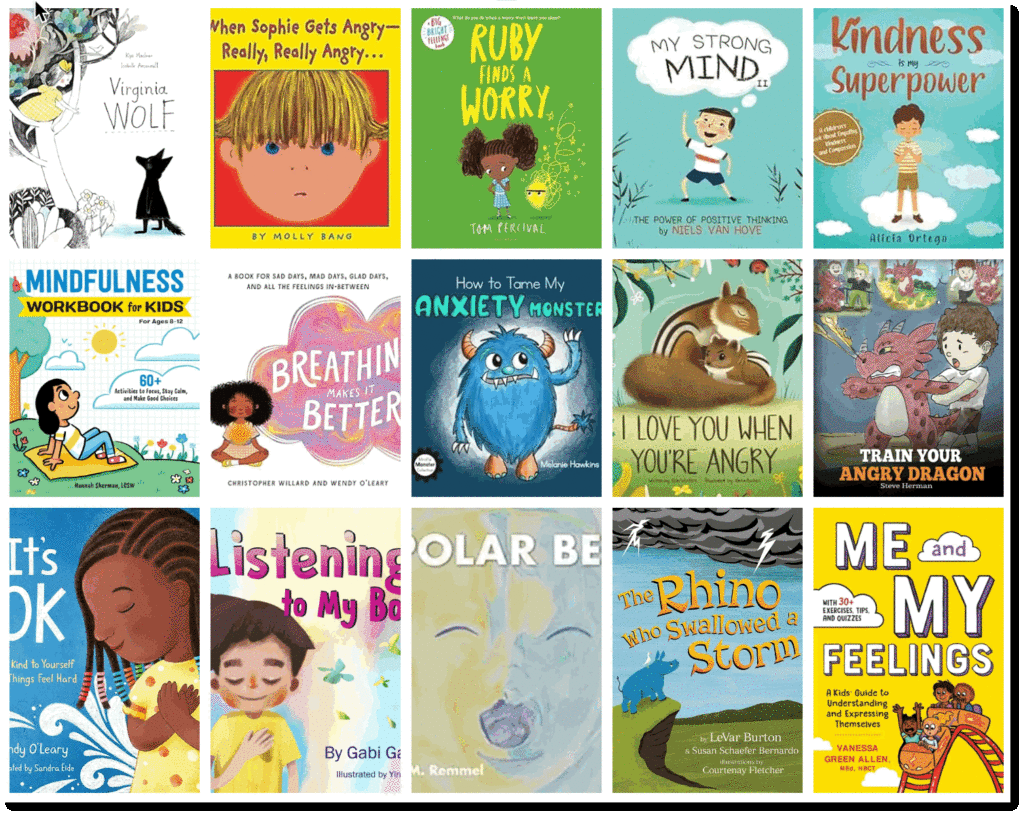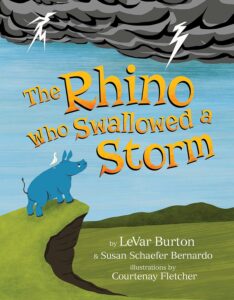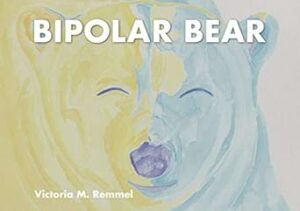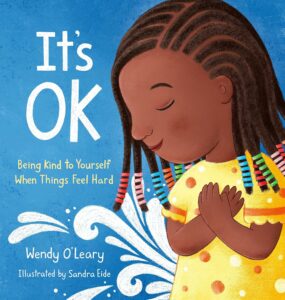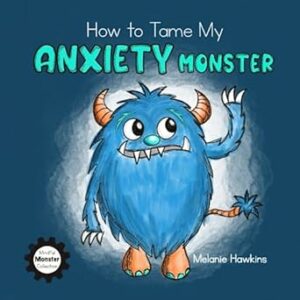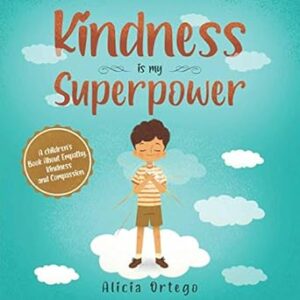Children’s books about mental health are the topic of our blog post today!
Navigating the emotional landscape of childhood has always been complex, but today it’s even more so with mounting statistics revealing concerning trends. According to a report by the World Health Organization, around 10-20% of children and adolescents worldwide experience mental health disorders. The CDC further notes that the prevalence of anxiety and depression among kids aged 6–17 years increased from 5.4% in 2003 to 8.4% in 2011–2012. These numbers underline the urgent need for resources that help address and alleviate mental health concerns in young people.
Books can serve as one such powerful tool. They not only entertain but also educate, providing children with a way to identify their emotions and better understand themselves. Literature has the power to transform, to illuminate the mind, and offer new perspectives, and what better time to start but in childhood?
In this post, I’ve curated a list of children’s books about mental health covering topics like anxiety, anger management, and positive thinking. These books offer engaging stories and actionable advice that kids can apply in real-world situations. And hey, don’t miss out on my other post that dives into mental health posters—a fantastic supplement to these reads that adds a visual layer of encouragement and understanding.
Children’s Books about Mental Health
Here are our top picks for children’s books about mental health:
1. Me and My Feelings, by Vanessa Green Allen
Navigating emotions can be a complex task for kids, and “Me and My Feelings” by Vanessa Green Allen offers a lifeline. The book is designed for children aged 7 to 10 and delves into managing those “big feelings” like anger, jealousy, or even fear. It’s filled with tangible activities, quizzes, and coping mechanisms that help children not only understand their own emotions but also those of others. If I had come across this book during my teaching years, it would’ve been a staple in my classroom resources to aid emotional literacy.
Buy Me and My Feelings on Amazon
2. The Rhino Who Swallowed a Storm, by LeVar Burton and Susan Schaefer Bernardo
LeVar Burton and Susan Schaefer Bernardo’s “The Rhino Who Swallowed a Storm” is an enchanting and layered tale about dealing with trauma and fears. Perfect for kids and parents alike, this poetic story unfolds within a story as Mica Mouse is comforted by her father reading about a rhino learning to cope with his emotional turmoil. While the plot centers on fantastical adventures and encounters, the underlying message beautifully conveys the importance of community and emotional support. I can’t help but think how incredible this would be as a read-aloud to facilitate conversations around emotional well-being in a classroom setting.
Buy The Rhino Who Swallowed a Storm, on Amazon
3. Virginia Wolf, by Kyo Maclear
“Virginia Wolf” explores the theme of emotional turmoil through the lens of a sibling relationship. Vanessa tries to cheer up her sister Virginia, who’s in a ‘wolfish’ mood. After several failed attempts, Vanessa discovers that creating a safe and imaginary space helps Virginia transform her emotions. Loosely based on the Woolf sisters, this story delves into the ups and downs of moods and emotions, and how creativity can be a refuge. This book is particularly poignant if you consider how the arts can be therapeutic, something that should never be underestimated in an educational setting.
4. Bipolar Bear: A Resource to Talk about Mental Health, by Victoria Remmel
“Bipolar Bear” by Victoria Remmel tackles the difficult subject of bipolar disorder in a way that’s accessible for children. Through the metaphorical journey of Bipolar Bear between the “bright North Pole” and the “dreary South Pole,” this book offers kids the tools to help find their way back to emotional stability. Interactive elements like cut-out sunglasses and flashlights add to the engagement factor. It’s a well-structured resource that can ease into a challenging discussion about mental health. In my own teaching experience, books like this were invaluable for addressing complex topics in a child-friendly manner.
5. Listening to My Body, by Gabi Garcia
“Listening to My Body” is an interactive guide that teaches kids the value of understanding their emotions through physical sensations. Designed to build emotional literacy, this book comes with numerous kid-friendly “Let’s Practice” activities. It empowers children to articulate how they feel not just emotionally but also physically, bridging the gap between body and mind. Trust me, this is the kind of tool that can be transformative in a classroom, helping kids engage in self-awareness and emotional regulation.
Buy Listening to My Body on Amazon
6. It’s OK: Being Kind to Yourself When Things Feel, by Wendy O’Leary
Targeting a younger audience aged 3-7, “It’s OK: Being Kind to Yourself When Things Feel” serves as a gentle introduction to the concept of self-compassion. The book includes simple affirmations and exercises focused on promoting kindness towards oneself, especially when grappling with challenging emotions. The heart of the book centers on showing kids that it’s okay to have feelings and to be kind to oneself during those moments. I’ve always been a fan of self-compassion and mindfulness in teaching; this book would fit right into that ethos.
7. Mindfulness Workbook for Kids, by Hannah Sherman
If you’re looking to equip kids with mindfulness tools, then “Mindfulness Workbook for Kids” by Hannah Sherman has got you covered. This book offers more than 60 mindfulness activities across various topics, aimed at helping kids act with kindness, tackle challenges, and manage their emotions. It starts with an intro to what mindfulness is and how it can benefit kids, making it an all-encompassing guide for youngsters. I can just see it now, transforming the first 10 minutes of a classroom setting into a mindfulness session using these activities.
Buy Mindfulness Workbook for Kids on Amazon
8. Breathing Makes It Better, by Christopher Willard and Wendy O’Leary
For the little ones between ages 3-6, “Breathing Makes It Better” zeroes in on the power of breathing in emotional regulation. Using rhythmic prose and delightful illustrations, the book guides children through breathing exercises when faced with a myriad of emotions like sadness, anger, and anxiety. It’s a simple yet impactful message that breath can serve as an anchor during emotional storms. I always found that teaching breathing techniques at an early age can pay off big time as kids grow older.
Buy Breathing Makes It Better on Amazon
9. How To Tame My Anxiety Monster, by Melanie Hawkins
“How To Tame My Anxiety Monster” takes a playful yet insightful approach to help children deal with anxiety. Through the story, kids learn various coping strategies that enable them to gain control over their “Anxiety Monster,” reducing its size and making it more manageable. What makes this book stand out is its back section, which is chock-full of valuable information for adults. It facilitates great discussions between children and caregivers—whether parents, teachers, or therapists—on how to cope with anxiety. Speaking from experience, resources like these can be game-changers in addressing the emotional well-being of children.
Buy How To Tame My Anxiety Monster on Amazon
10. I Love You When You’re Angry, by Erin Winters
Crafted by Licensed Professional Counselor Erin Winters, “I Love You When You’re Angry” is a gem of a book that focuses on the concept of unconditional love. Through sweet animal illustrations and simple text, the book reassures children that they are loved—no matter what their emotional state is. It normalizes feelings and emphasizes the notion that good and bad days end the same way: with love. The book even comes with an interactive feelings chart and questions at the end, making it a comprehensive tool for both biological and blended families. I’ve always believed that the classroom should also be a place where kids learn about emotional security, and this book fits that bill perfectly.
Buy I Love You When You’re Angry on Amazon
11. Train Your Angry Dragon, by Steve Herman
“Train Your Angry Dragon” puts a whimsical spin on teaching kids about emotional regulation, particularly anger management. If you’re wondering how to deal with a pet dragon’s fiery temper, this book’s got answers! It engages children with fun and charming illustrations while delivering the message that emotions like anger can be managed. Books like these can make complex emotional lessons more relatable to kids, and I can see this being a hit for a read-aloud session followed by a class discussion on handling anger.
Buy Train Your Angry Dragon on Amazon
12. Kindness is My Superpower, by Alicia Ortego
Alicia Ortego’s “Kindness is My Superpower” is an excellent social-emotional learning (SEL) book that centers on kindness, something we can all agree is pivotal in any social setting—classroom included. This book not only conveys the importance of being caring and considerate but also does so through a charming story featuring Lucas, a little superhero. Lucas’s journey in the book teaches children that it’s okay to err as long as you own up to it and say, “I’m sorry.” It also promotes acceptance and empathy, values that I think are invaluable for students to learn and integrate into their behavior.
Buy Kindness is My Superpower on Amazon
13. My Strong Mind II: The Power of Positive Thinking, by Niels van Hove
“My Strong Mind II: The Power of Positive Thinking” is the second book in a series that aims to instill mental resilience in kids. Authored by Niels van Hove, it introduces us to Jack, a boy who uses his strong mind to navigate everyday challenges like peer pressure and anger management. The book’s approach is research-backed, focusing on the scientifically validated 4 Cs of mental toughness: Commitment, Control, Confidence, and Challenge. It’s a good read especially for primary-aged children who can benefit from starting resilience training early. Having taught kids myself, I can vouch for the positive impact of integrating SEL concepts like these into early education.
Buy My Strong Mind II on Amazon
14. Ruby Finds a Worry, by Tom Percival
“Ruby Finds a Worry” is a touching book that addresses the issue of anxiety in children in a way that’s easy to understand. Ruby discovers that worries can grow if not addressed, but sharing her feelings makes a big difference. As part of the Big Bright Feelings picture book series, it serves as an excellent platform for opening up discussions about emotional health. During my teaching years, I noticed how crucial it is for children to recognize their emotions and share them, and this book serves that purpose excellently.
Buy Ruby Finds a Worry on Amazon
15. When Sophie Gets Angry – Really, Really Angry, by Molly Bang
In Molly Bang’s Caldecott Honor book, “When Sophie Gets Angry – Really, Really Angry,” Sophie’s experiences offer a realistic portrayal of the challenges children face when dealing with anger. What stands out is that it provides a safe starting point for conversations between children and adults about anger and emotions. You can’t gloss over the fact that kids, just like adults, have complex feelings, and addressing them head-on can really help with emotional development.
Buy When Sophie Gets Angry on Amazon
Final thoughts
As we wrap up this exploration of children’s books about mental health, it’s evident that literature can be a profound tool in fostering emotional intelligence and well-being in young minds. The stats don’t lie: kids today are facing increasing mental health challenges, making it crucial for parents, educators, and caregivers to have resources at their fingertips.
These chidlren’s books about mental health offer life lessons, coping mechanisms, and, most importantly, the vocabulary to express complex emotions. Whether you’re a teacher looking to enrich your classroom library or a parent hoping to engage in meaningful conversations with your child, these books provide valuable groundwork.



